- Home
- Ricoh Global Newsroom
- Stories
- Ricoh’s Next-generation Meeting Space RICOH PRISM Exemplifies a New Vision for Workplaces by Drawing Creativity through Fun Working
Products & Services Ricoh’s Next-generation Meeting Space RICOH PRISM Exemplifies a New Vision for Workplaces by Drawing Creativity through Fun Working
- Fulfillment through Work
- Innovation
- Creativity from Work

Contents
- How RICOH PRISM works
- Digital technology intensifies meeting experiences
- Embodying Fulfillment through Work
- Project concept 'digital endorphins' to elevate spatial experiences
- Creating a world in which everyone can contribute to creative work
- Broadening the value proposition of Fulfillment through Work
A fast automating and digitizing business landscape is compelling companies to explore ways to best harness human creativity and cultivate people-centric workstyles.
It is considerations like these that inspired Ricoh to fashion a forward-looking work paradigm in which special spaces leverage its core optical, microdevices, and artificial intelligence (AI) technologies.
As well as fostering communication across teams, the company seeks to elevate individual and collective creativity by digitizing human interactions encompassing speech, actions, and emotions. Conventional workplace setups overlook these facets of communication.
One fruit of the company’s endeavors is RICOH PRISM, a ground-breaking next-generation meeting space whose technology that helps teams to work more creatively by engaging people’s five senses. We asked Haruki Murata, “Fulfillment through Work” Value Creation Dept., Future Design Center, who leads the RICOH PRISM project, to take us behind the scenes of its development and outline its services.
How RICOH PRISM works
RICOH PRISM technology employs visual and auditory elements to excite people and facilitate team communication.
Meeting participants pass through a passage to enter a magical space of just over five square meters. All walls and the floor are screens. Depending on for the meeting purpose, participants can select and use applications from three categories in combination. One is Travel, to experience the artist-designed space. The other two are Engage, to support communication, and Organize, to maintain the body and mind.
The Engage category helps people come up with ideas and build consensus. They are crucial for efficient and creative meetings. This immersive space leverages images and sounds so participants can focus on brainstorming and discussions. There are several useful apps in this category. Persona, for example, is for people to better understand the communication styles of others. Gallery projects images on entire walls for presentations. Brain Wall supports sharing, voting, and other tools for organizing ideas efficiently.
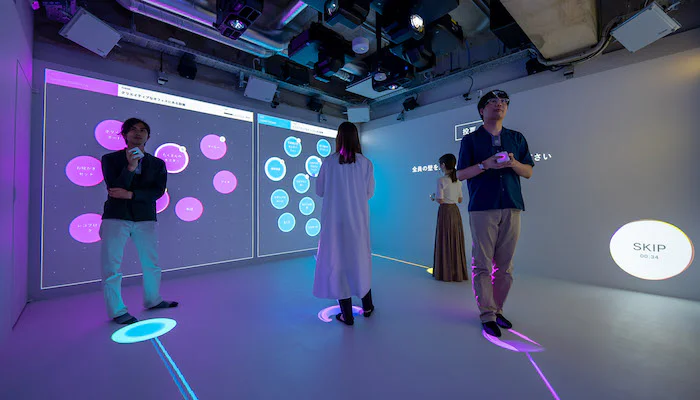
Digital technology intensifies meeting experiences
Murata, who has been leading the RICOH PRISM project since its inception, says that, "This interactive meeting space unleashes the creativity of participants."
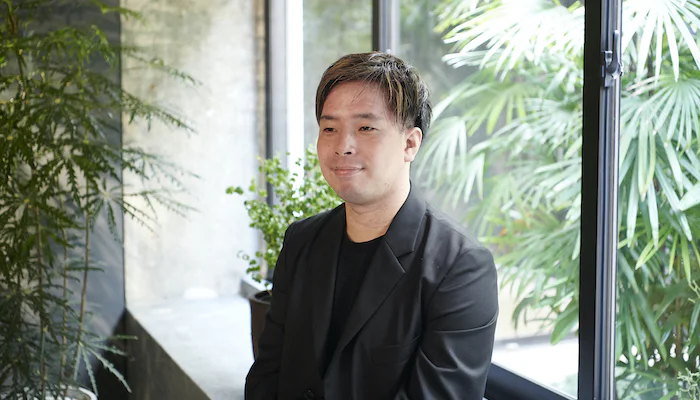
Haruki Murata, "Fulfillment though Work" Value Creation Dept., Future Design Center, Ricoh Company, Ltd.
He notes that, "Cameras, microphones, and wearables monitor what participants are doing and provide real-time suggestions on how best to stage the environment and hold meetings. People can visually see the acquired data as the effect to enhance the meeting’s creativity so they can focus entirely on meeting proceedings."
After meetings, participants can draw on the data to review details and outcomes. Murata says that, "They can analyze how people reacted to what they said based on the volume of comments and number of assenting nods. They can learn how convincing people found them, whether others accepted their ideas, and even how lively conversations were. It all helps improve people conduct meetings and behave in them."
RICOH PRISM becomes more effective with ongoing use. Murata says that, "RICOH PRISM learns from you registering people and convening a series of gatherings. It suggests optimal spaces and meeting approaches for each participant. It essentially caters to what you find comfortable."
RICOH PRISM is one fruit of Ricoh’s ongoing quest to support workers in helping shape the offices of tomorrow. Says Murata, "The COVID-19 pandemic essentially transformed offices into platforms for dealing with pressing purposes, a prominent example being meetings. With limited time to meet others in person, you can interact intensely in a meeting room to get things done and use the time left to get to know your colleagues better. I believe that RICOH PRISM can offer such office environments."
Embodying Fulfillment through Work
The RICOH PRISM project originated six years ago. After becoming Ricoh’s president in 2017, Yoshinori "Jake" Yamashita formed the 2030 Scenario Committee. That body selected 24 young volunteers and executives to set about imagining the company’s future and commercializing their ideas.
Murata says that, "In the course of discussing the future of business, we concluded the roles of individuals should come to the fore as digitization progresses. We looked back through Ricoh’s history so we could get a picture of where the company might head. All members concurred that Ricoh had always focused on delivering value to working people and that it should continue to do so. It was from there that we started to materialize our Fulfillment through Work vision."
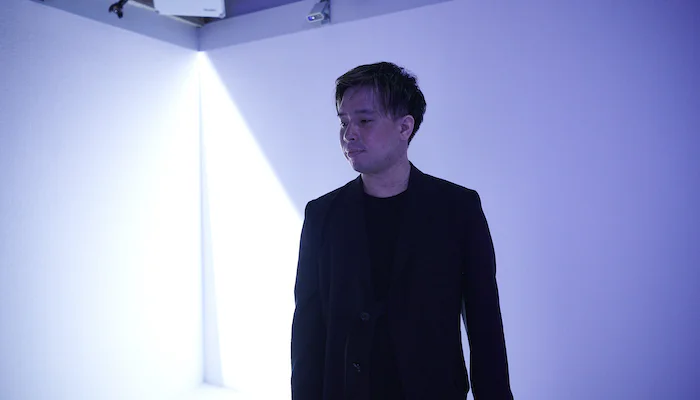
Four people from the 2030 Scenario Committee set about getting the RICOH PRISM project under way. Murata and his team set up discussions with Ricoh business partners and other entities to gather and commercialize ideas. They spoke with almost 300 people in this process.
Murata recalls that, "Looking back, I’m a little surprised that people set aside time to talk with us given that we didn’t have any proposals or products to show them. We met executives, engineers, and researchers from companies around Japan and overseas. We told them all that we wanted to create value that would help people find their work fulfilling and asked how we should go about helping that to happen. These gatherings proved valuable. We came to realize that meeting others to craft new ideas would always remain a central feature of work. That being the case, we thought we should devote our energies to creating the meeting room of the future. This is how our project came about."
Project concept 'digital endorphins' to elevate spatial experiences
Murata adds that, "Discussions led the team to come up with the concept of 'digital endorphins.' The thinking was that personal assumptions and moods are central to creativity. Many people find going to concert halls uplifting. They get a kick out of their environments. We thought it would be brilliant if we could create a meeting room with such functionality. The result was a rough concept of “Brain wave meeting room."
Murata says that brain wave not only fuels ideas but also brings teams together to reach unified conclusions. The RICOH PRISM serves as a brain wave meeting room because individuals at a loss for ideas or teams that simply cannot reach consensuses can enter the room and have a fruitful meeting.
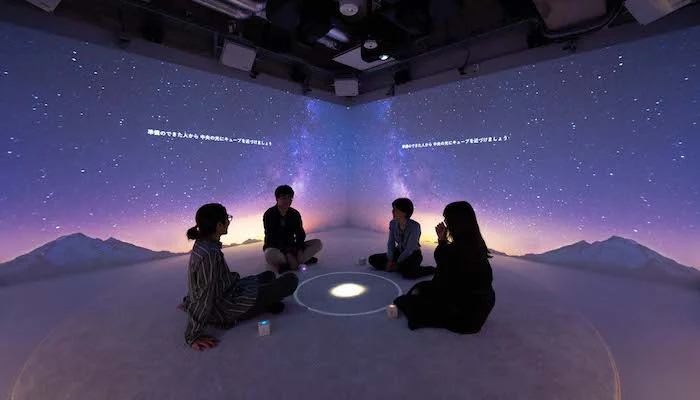
Once Murata and his team settled on its concept in 2019, it embarked on developing what it envisaged as the meeting room of tomorrow, experimenting with projection mapping tools and other approaches that might elevate experiences for participants in gatherings. The pandemic that started in 2020 underscored the importance of interacting with others, propelling the project closer to its ultimate form.
Recalls Murata, "The pandemic broke out while we were exploring ways to make meetings more valuable and actually threatened to undermine the notion of meeting in person at all. I remember at the time people were constantly questioning the need to gather. This made it even more important to divine what made gathering with others uniquely beneficial. We made it clear that meetings are essential to drive work progress, which attracted more people to join our endeavor and push forward with development. It was around that time that Ricoh opened 3L, a practical research facility for enhancing worker creativity, and it was there that we set up RICOH PRISM."
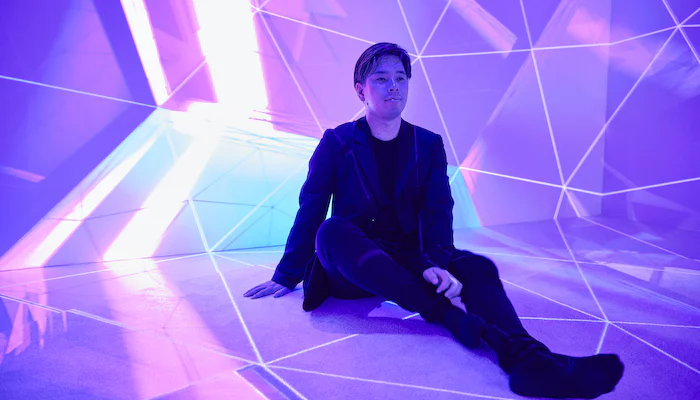
Creating a world in which everyone can contribute to creative work
Ricoh’s desire to present a new vision for the future of work lies at the heart of RICOH PRISM. Says Murata, "As AI and the Internet of Things embed themselves in economies and automation gains traction, the fulfillment that people get from works that only they can handle will be indispensable to satisfying lives. That’s why we have to make work fun, not a chore. Mark my words, work will be more entertaining."
RICOH PRISM is a vehicle for materializing the workplace of tomorrow. Notes Murata, "Ricoh is uniquely positioned to create a future-oriented meeting paradigm because it has gained so much expertise from creating worker-centric products and offering meeting space setups that generate value."
RICOH PRISM will revolutionize approach to and value perceptions of creativity. Says Murata, "You might think that only highly creative individuals can handle works that are beyond the capabilities of AI. You would be wrong, because even the primitive acts of people themselves are creative. Digital technology can empower people to become more creative."
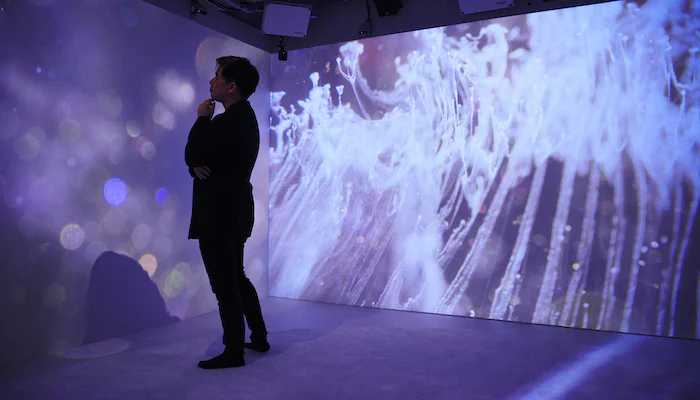
He adds that, "Imagine, for example, what happens to an idea that AI comes up with. That’s fine, as people can then discuss it and reach a consensus. Once we assign AI to come up with worthwhile ideas and discard ones that are unfeasible, it will still be possible for work to progress because people will happily discuss the ideas that are good. Offering comfortable meeting spaces will lead to results, making it easier for people to work and eliminating disparities between them. I want to leverage RICOH PRISM in a quest to help realize a world in which taking part in creative work is open to everyone, not just people who are adept at generating ideas."
Broadening the value proposition of Fulfillment through Work
The near-term goal of Murata’s Fulfillment through Work Office, is to have more people try RICOH PRISM. While installation is needed to set this up in an office, his team is currently developing a service that does not require large spaces or installation and just needs three displays to run the applications.
Says Murata, "We want to make RICOH PRISM even more accessible for customers to deploy and make it more valuable for them by adding more applications and enhancing its functionality." He looks to not only provide meeting spaces but also a diverse services that help deliver Fulfillment through Work.
He concludes that, "I believe that there are many ways to generate more value from Fulfillment through Work. I want to keep creating value for workers by collaborating with people inside and outside Ricoh."
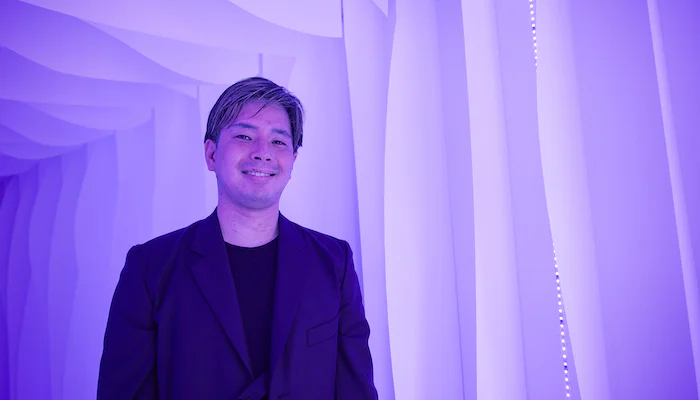
Related Articles
Products & Services
Related Articles
#Fulfillment through Work
- Home
- Ricoh Global Newsroom
- Stories
- Ricoh’s Next-generation Meeting Space RICOH PRISM Exemplifies a New Vision for Workplaces by Drawing Creativity through Fun Working









